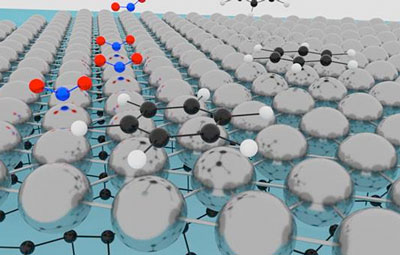| Sep 14, 2020 | |
Single atom-thin platinum makes a great chemical sensor(Nanowerk News) Researchers at Chalmers University of Technology, Sweden, together with colleagues from other universities, have discovered the possibility to prepare one-atom thin platinum for use as a chemical sensor. |
|
| The results were recently published in the scientific journal Advanced Material Interfaces ("Chemical Sensing with Atomically Thin Platinum Templated by a 2D Insulator"). | |
| The essence of the research is the development of 2D materials beyond graphene. | |
| “Atomically thin platinum could be useful for ultra-sensitive and fast electrical detection of chemicals. We have studied the case of platinum in great detail, but other metals like palladium produce similar results”, says Samuel Lara Avila, Associate Professor at the Quantum Device Physics Laboratory and one of the authors of the article. | |
 |
|
| A schematic of platinum atoms deposited on the surface of the carbon ‘buffer-layer’, which is a graphene-like 2D insulating material grown epitaxially on silicon carbide, that enables two-dimensional growth of platinum. (Image: Hans He / Chalmers University of Technology) | |
| The researchers used the sensitive chemical-to-electrical transduction capability of atomically thin platinum to detect toxic gases at the parts-per-billion level. They demonstrated this with detection of benzene, a compound that is carcinogenic even at very small concentrations, and for which no low-cost detection apparatus exists. | |
| “This new approach, using atomically thin metals, is very promising for future air-quality monitoring applications”, says Jens Eriksson, Head of the Applied sensor science unit at Linköping University and a co-author of the paper. | |
| Boosting the sensitivity of solid-state gas sensors by incorporating nanostructured materials as the active sensing element can be complicated by effects on the interfaces. Interfaces at nanoparticles, grains, or contacts may result in nonlinear current–voltage response, high electrical resistance, and ultimately, electric noise that limits the sensor read-out. | |
| This work reports the possibility to prepare electrically continuous platinum layers on one atom thickness, by physical vapour deposition on the carbon zero layer (also known as the buffer layer) grown epitaxially on silicon carbide. | |
| With a 3–4 Å thin Pt layer, the electrical conductivity of the metal is strongly modulated when interacting with chemical analytes, due to charges being transferred to/from Pt. The strong interaction with chemical species, together with the scalability of the material, enables the fabrication of chemiresistor devices for electrical read-out of chemical species with sub part-per-billion (ppb) detection limits. | |
| The 2D system formed by atomically thin Pt on the carbon zero layer on SiC opens up a route for resilient and high sensitivity chemical detection and can be the path for designing new heterogenous catalysts with superior activity and selectivity. |
| Source: Chalmers University of Technology | |
|
Subscribe to a free copy of one of our daily Nanowerk Newsletter Email Digests with a compilation of all of the day's news. |
